 Kolkata (Bengali: কলকাতা Kolkata, Hindi: कोलकाता Kolkātā), formerly Calcutta, is the capital and largest city of West Bengal and the cultural capital of India. Kolkata is an "in your face" city that shocks and charms the unsuspecting visitor. Long known as the cultural capital of India and home to the Bengali Renaissance, the "City of Joy" (the sobriquet became more famous after the publication of a novel of the same name) continues to spawn generations of poets, writers, film directors and Nobel Prize winners. If your trip only allows for a visit to one or two of India's metropolitan cities, then definitely consider placing Kolkata on your itinerary. Kolkata is arguably one of the most socially, culturally and politically progressive cities in India. Love it or hate it, you definitely won't forget the "City of Joy".
Kolkata (Bengali: কলকাতা Kolkata, Hindi: कोलकाता Kolkātā), formerly Calcutta, is the capital and largest city of West Bengal and the cultural capital of India. Kolkata is an "in your face" city that shocks and charms the unsuspecting visitor. Long known as the cultural capital of India and home to the Bengali Renaissance, the "City of Joy" (the sobriquet became more famous after the publication of a novel of the same name) continues to spawn generations of poets, writers, film directors and Nobel Prize winners. If your trip only allows for a visit to one or two of India's metropolitan cities, then definitely consider placing Kolkata on your itinerary. Kolkata is arguably one of the most socially, culturally and politically progressive cities in India. Love it or hate it, you definitely won't forget the "City of Joy".
Districts
This article covers the eastern part of the so-called Greater Kolkata, which has an area of . The western part of the metropolitan area is covered as separate cities under the Hooghly and Howrah region. Jaynagar Majilpur is also covered separately.
Inner Kolkata
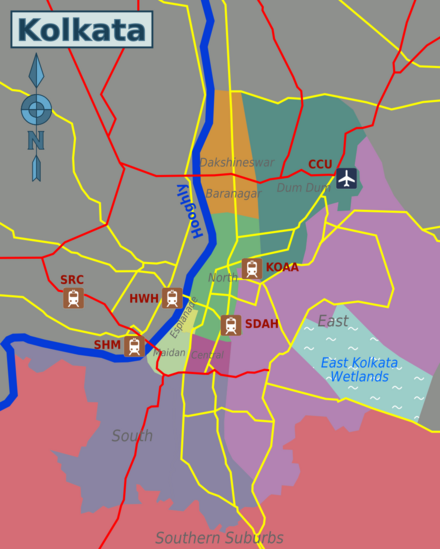
The central business district of Kolkata.
The colonial district is still the central administrative district of Kolkata and is considered one of the best remnants of British colonial architecture in the world. It is also the primary hub of public transport in the city.
Nicknamed the "Lungs of Kolkata", the Maidan is a huge open field with numerous festivals and sports.
Rapidly developing, especially the IT sector and home to shopping emporiums, amusement parks, luxury hotels, convention centres, speciality hospitals, condominium complexes, malls and multiplexes. Science City is a major attraction. Salt Lake Stadium is a major occasional crowd puller. A large number of hospitals attract patients from the metropolis and beyond.
The oldest area of the city, a fascinating district dominated by narrow little lanes and hundreds of century-old buildings. North Kolkata was known as the "Black Town" during the British period as it was home to the native population.
The posh and new part of the city with rapidly mushrooming localities. Features Alipore Zoo, the West Bengal film industry, one of the top universities in the state and several museums.
Suburban Kolkata
Understand
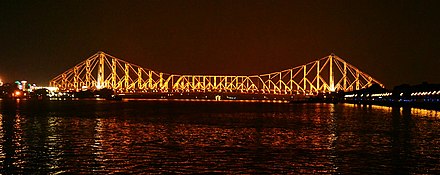
Kolkata (KOHL-kah-tah) is the main business, commercial and financial hub of eastern India. Spread along the eastern banks of the Hooghly River, Kolkata was once the administrative centre of the British Raj, governing a vast region that stretched from Pakistan to Burma (Myanmar) and the "second city of the British Empire after London".
Name
The name is derived from Kalikata, the name of one of the three villages in the area before the arrival of the British. There has been much debate regarding the origin of the name. Some say the name derives from kālīkṣetra, meaning the "land of [the goddess] Kali". Another theory is that the place used to specialise in quicklime (kôlicun) and coir rope (kata).
The name was officially changed from Calcutta to Kolkata in 2001 by the then-left Government of West Bengal. However, the name "Calcutta" still survives in the names of certain institutions.
History
Kolkata's history is intimately related to the British East India Company, which arrived in 1690, and to British India, of which Calcutta became the capital in 1772. Job Charnock was widely known as the founder of Calcutta. There were 3 villages named Sutanuti, Gobindapur and Kalikata. Later the village Kalikata became the city of Kolkata. But some Indian historians have disputed this claim, arguing that Kolkata developed naturally over a period, centred on the ancient Kali temple at Kalighat and the port at Kidderpore.
Whatever its origins, Calcutta flowered as the capital of British India during the 19th century, the heyday of the Raj. The University of Calcutta, the first modern Indian university, was founded here in 1857. Calcutta became the centre of Indian arts and literature and the national movement for independence got its start here. However, with the transfer of the capital to Delhi in 1911 and the pains of the partition of Bengal in 1947, a violent repressive and feudal state machinery was operational for nearly the first two decades after independence. Calcutta became plagued by power outages, labour unrest, disappearing industry and violence from the ideologically-motivated Maoist movement (the Naxalbari movement) in the 1970s. In 1985, the then-Prime Minister of India Rajiv Gandhi referred to the city as a "dying city" because of the social and political traumas.
In 1977, a "Left Front" coalition of the Communist and Marxist parties came to power and ruled West Bengal for 34 years. This is reflected in street names and memorials in the city with names like Lenin Sarani and Ho Chi Minh Sarani. During this period, the various egalitarian approaches implemented at improving the living standards of the downtrodden have helped the city in bridging the wealth gap and decreasing impoverishment.
Economy
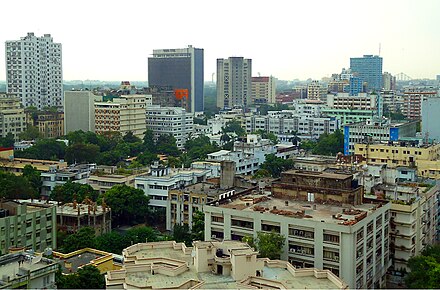
Once India's leading city, Kolkata experienced a steady economic decline in the decades following India's independence due to a steep population increase and a rise in militant trade unionism. From the 1960s to the late 1990s, several factories were closed and businesses relocated.
Despite this, the city's fortunes have looked up since the early 1990s, coinciding with the liberalisation of the Indian economy. Since 2000, information technology (IT) services revitalised the city's stagnant economy. With the formation of New Town and the extension of Bidhannagar's Sector-V, Kolkata is rapidly turning into a pro-IT city. It also has experienced growth in the manufacturing sector, with industrial estates at Bantala, Kasba, Taratala etc.
Kolkata is fast developing into a modern infotech city with various private sector companies setting up shops here. Its economy has been amongst the fastest-growing in India. The landscape of the city is also fast changing with flyovers, gardens and several new commercial establishments. The new metro city is characterised by popular spots such as multiplexes, theatres, clubs, pubs, coffee shops, and museums.
The old Central Business District (CBD) is where the seat of the Government of West Bengal is located, along with many other government offices. Several banks have their corporate or regional headquarters around the BBD Bagh area (named after the revolutionaries Benoy Basu, Badal Gupta and Dinesh Gupta who forced entry into the Writers' Building, the epicentre of the British Raj government in Bengal). Many of Kolkata's older business groups have their main offices here. The area is a mix of multi-storeyed office blocks and colonial buildings.
The newer CBD is around the south of Park Street, Camac Street and Acharya Jagadish Chandra Bose Road. Several high-rise office blocks including some of Kolkata's tallest commercial buildings are in this area. An even newer CBD is lying between Bidhannagar and Kolkata Airport, which is part of an effort to relieve congestion in the core city. Many government offices have shifted to high-rise office buildings lining Bidhannagar's Central Park.
Culture
 Kolkata is known for its literary, artistic and revolutionary heritage and it was the birthplace of modern Indian literary and artistic thought. The city has a tradition of political graffiti depicting everything from outrageous slander to witty banter and limericks, caricatures and propaganda.
Kolkata is known for its literary, artistic and revolutionary heritage and it was the birthplace of modern Indian literary and artistic thought. The city has a tradition of political graffiti depicting everything from outrageous slander to witty banter and limericks, caricatures and propaganda.
Kolkata has been called the "City of Palaces", because of the numerous palatial mansions built all over the city. During British rule, the city witnessed a spate of frenzied construction activity of buildings largely influenced by the conscious intermingling of Gothic, Baroque, Roman, Oriental and Islamic schools of design. The layout of much of the architectural variety in Kolkata owes its origins to European styles and tastes imported by the British and, to a much lesser extent, the Portuguese and French. However, many of these structures are in various stages of decay, as of 2022. Some of the major buildings of this period are well maintained and several buildings have been declared as heritage structures.
Kolkata is also famous for the film industry around Tollygunge, known as "Tollywood" (a blend of Tollygunge and Hollywood). From the beginning of the silent era in 1919 to the talking era in the 1930s and the golden days of the 1950s to the 1970s has been a chequered history. It has seen renowned filmmakers like Satyajit Ray, Ritwik Ghatak, Mrinal Sen and Tapan Sinha.
Orientation
Place name changes
After India's independence, many colonial place names in Kolkata were changed, including streets. They were named after either freedom activists (Netaji Subhas Chandra Bose, Rash Behari Bose, Mahatma Gandhi), prime ministers (Jawaharlal Nehru, Indira Gandhi), famed scientists (Jagadish Chandra Bose, Prafulla Chandra Ray) or international personalities (Lenin, Ho Chi Minh, Shakespeare).
For a traveller, the practical problem would be that many places would have multiple names in usage. The new names are seen on maps and posters, while the old names are still used by some locals. So you need to be careful about specifying which place you need to get to. The district articles use the most common name in usage, with the official name in parentheses.
A few important name changes to remember are:
- "Central Avenue" is now "Chittaranjan Avenue"
- "Chowringhee Road" is now "Jawaharlal Nehru Road'
- "Dalhousie Square" is now "BBD Bagh"
- "Park Street" is now "Mother Teresa Sarani"
- "Lower Circular Road" is now "Acharya Jagadish Chandra Bose Road" or "AJC Bose Road"
Kolkata can be roughly divided into two sections along Park Street. North of Park Street is the more congested part of the city. South of Park Street is the slightly better-planned section of the city. South Kolkata is better planned with wider roads and a better-equipped police force for keeping law and order. The better planning in South Kolkata is because it was built much later. The North is the real, old Kolkata and most of the oldest families and buildings are there.
Over the past several years the city has expanded to the south and the east, with the Greater Kolkata region spanning over , from Kalyani to Jaynagar Majilpur. The region also includes the planned townships of Bidhannagar and New Town.
Kolkata consists of neighbourhoods (Bengali: পাড়া, para) that possess a strong sense of community. They have their own community clubs and sometimes, playgrounds.
Between the river Hooghly and Chowringhee Road, the Maidan (open field) is said to be the lungs of Kolkata. The lush green meadow also houses Victoria Memorial, Eden Gardens, and several sporting clubs. Kolkatans love to stroll in the Maidan.
Heavy construction activity along the Eastern Metropolitan Bypass has been changing the face of the city. Luxury hotels, convention centres, speciality hospitals, condominium complexes, malls and multiplexes are coming up at a rapid pace. The city's expansion on the eastern side is spearheaded by the construction of a new satellite township called New Town adjacent to the well-planned Bidhannagar. It is one of the largest planned urban developments in India.
The residential buildings are mainly low-rise and comprise older colonial buildings and numerous new four-storied apartment blocks. 10- to 12-storey apartment blocks have come up in large numbers in South Kolkata. The city has relaxed its rules on high-rise construction and 20-storey buildings are becoming more common.
However, slums and dilapidated structures exist in many pockets of the city and house over 25% of the city's population (2001 census). Slum redevelopment schemes have helped improve living conditions to a small extent, but efforts to shift slum dwellers to newer developments have often met with resistance and failure because many of the slums are in prime areas of the city and the slum dwellers who are integrated into the social structure of the neighbourhood do not want to shift.
People
Kolkata is a multicultural and cosmopolitan city, with diversity from all over India as well including Europeans (including Germans, Armenians, and others) and other Asians (including Chinese, Sinhalese, and Tibetans). Kolkata is also notable for being home to India's largest Chinatown, which continues to be home to many ethnic Chinese residents whose families have lived in India for several generations.
Climate
Kolkata has three main seasons: summer, monsoon, and winter. Summer, from March–May, is hot and humid with temperatures touching 38-42°C. Monsoon starts in June and lasts till September or October. This is the time when heavy showers sometimes lead to waterlogging in a few areas. Winter is from November to February. This is the best season to visit the city, as the weather is very pleasant with temperatures ranging between 8 and 20°.
Visitor information
- Tourism Centre, 3/2, BBD Bagh E (near Great Eastern Hotel), 22.57045°, 88.35014°, +91 33 2210 3199, +91 33 2248 8271. The staff at the Tourism Centre is very helpful and the centre has a lot of information on West Bengal tourism. You can book a government lodge there before travelling to your favourite destination. 2022-11-26
Get in
By plane

- [Netaji Subhas Chandra Bose International Airport](https://www.aai.aero/en/airports/kolkata) (IATA: CCU, Dum Dum Airport, Kolkata Airport), Jessore Rd (about 18 km outside the city centre), 22.653889°, 88.446667°, +91 33 2511 8036, +91 33 2511 8787, +91 33 3987 4987, apdkolkata@aai.aero. The airport has excellent connectivity with most of the major cities in India, including Delhi, Mumbai, Bangalore and Hyderabad. It is a major centre for flights to North-Eastern India, Bangladesh, Bhutan, Southeast Asia and the Middle East cities of Dubai and Doha. 2022-09-09
The airport has a well-established facility of prepaid taxis and air-conditioned buses connecting it to the city centre. Parking facilities at the airport terminal include two underground parking levels accommodating 3,000 cars, and outdoor car parking which can handle an additional 2,000 cars.
Transport options to central Kolkata:
- By bus: State-run air-conditioned buses are available to get into the city centre. Cheaper, and hassle-free, and since you can hail a taxi anywhere in the city centre to take you to your final destination, you do not need to worry. The buses are parked outside the arrival gate at the integrated terminal. Do not be dissuaded by the taxi touts, who would try and make you believe that the buses do not run anymore.
- By taxi: In case you are arriving at busy hours, it is better to get a prepaid taxi (₹150-250), which takes you directly to your destination. There is no practice of tipping taxi drivers anywhere in India. Moreover, app-based cab services (such as Ola and Uber) are also available from the airport.
By train
See also: Rail travel in India
Kolkata is served by five major railway stations across the urban agglomeration, which connects the city to almost all the major stations in India. Most local trains serving Greater Kolkata run from Howrah and Sealdah stations. The trains run as far as Lalgola (near Murshidabad) at the north, Hasnabad at the east, Namkhana at the south, Midnapore at the southwest and Bardhaman at the west.
Howrah railway station
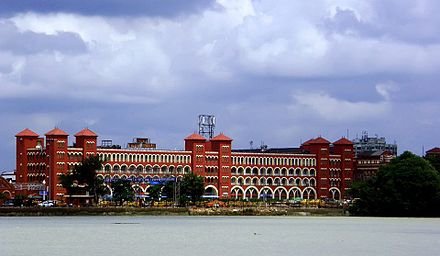
- Howrah railway station (station code: HWH), Lower Foreshore Rd, Howrah, 22.582871°, 88.342811°. The largest railway complex in India with over 600 trains arriving per day, including local trains. There is a Yatri Niwas (railway's travellers' lodge) with accommodation. 2018-11-17 Transport options to central Kolkata:
- By bus: There's a huge bus terminus between Howrah station and the Howrah Bridge. Air-conditioned buses are available between Howrah Station and Kolkata Airport.
- By car: The station platforms have carriageways for cars within the complex. Salkia Flyover at the end of the platforms allows the cars to exit the complex quickly. After exiting the complex, take the Howrah Bridge and cross the Hooghly River.
- By taxi: There's a big taxi stand outside Howrah station, where iconic yellow Ambassador taxis are parked in long queues.
- By ferry: There are ferries (₹5) opposite the station that can get you to the opposite side of the river, from where you can arrange onward transport with anything from taxis to public buses to rickshaws.
- By metro: As of 2022, Howrah is not served by the Kolkata Metro network. However, the East–West Line [green] is expected to connect Howrah by 2023. It will be the first underwater metro service in India.
Kolkata railway station
_01.jpg/440px-Kolkata_Railway_Station_(KOAA)_01.jpg)
- Kolkata railway station (station code: KOAA), Chitpur, 22.601277°, 88.384147°. Opened in 2009, it receives a number of trains which used to terminate at Sealdah station. The station is linked to the Sealdah-Ranaghat Line and is served by the Eastern Railway for trains to Bandel, Kalyani Simanta, Santipur, Krishnanagar, Dankuni, Bangaon, Hasnabad and others. There are five platforms in the station. The first two platforms are used by only suburban trains and the remaining three are used by long-distance trains. Kolkata station runs many long-distance express trains including two pairs of the Garib Rath Express, the Khwaja Garib Nawaz Madar–Kolkata Express etc. and one long-distance passenger train to Lalgola. There are two international trains from Bangladesh, the Maitree Express runs from Dhaka three times per week and the Bandhan Express runs from Khulna once per week. 2022-10-11
Transport options to central Kolkata:
- By bus: The bus routes from the station are:
- K1: Hatishala–Kolkata Station, via Newtown, Karunamoyee, City Center I, Ultadanga Station, Shyambazar and RG Kar Hospital
- KB22: Kolkata Station–Jamirgachi, via RG Kar Hospital, Shyambazar, Ultadanga Station, City Center I, Central Park, Karunamoyee and Newtown
Sealdah railway station

- Sealdah railway station (station code: SDAH), APC Rd, Sealdah, 22.567966°, 88.371105°. One of the busiest railway stations in India with a huge number of people commuting to the city for work. The station is divided into Sealdah North, Sealdah Main and Sealdah South. There are 21 platforms in the station, five of which are in Sealdah North, nine in Sealdah Main and seven in Sealdah South. 2022-10-11
Transport options to central Kolkata:
- By bus: Although there's a bus stop named Sealdah, the stop is about north of Sealdah station. The nearest bus stop to the station is at Sealdah Court.
- By metro: Sealdah is served by the Green Line [green] since 2022. One can take a metro from Sealdah to reach their destination in East Kolkata.
- By taxi: Although there's a taxi stand near the station, never hire a taxi from there as they ask for higher fares for taxis. There are pre-paid taxis to enter the city. The pre-paid taxi stands just outside the station's main entrance. The counter is under a tin shed.
- By tram: Although there's a tram stop named Sealdah, the stop is about north of Sealdah station. There used to be a tram stop closer to the station but has been closed in 2019.
Santragachi Junction railway station
- Santragachi Junction railway station (station code: SRC), Santragachi, Howrah, 22.5838°, 88.2843°. Most all Howrah/Shalimar bound express/mail trains stop here. Also serves local trains from Howrah, Purba Medinipur and Paschim Medinipur districts. A few trains from Ajmer, Porbandar, and Nanded and a Vivek Express from Mangalore Central terminate here. There are taxi stands and bus stands, and a Volvo bus service to connect this area to Kolkata Airport. 2022-12-27
Shalimar railway station
- Shalimar railway station (station code: SHM), Shibpur, Howrah, 22.556389°, 88.314722°. A small railway station compared to Howrah station, which handles a few EMU trains and a few express trains. 2022-12-27
By bus
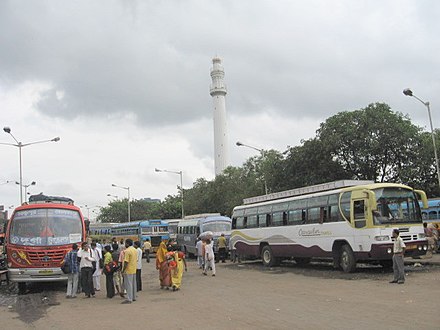 Kolkata is well served by buses from destinations both inside and outside India. There are buses from Bangladesh, North-Eastern India, Odisha and Sikkim.
Kolkata is well served by buses from destinations both inside and outside India. There are buses from Bangladesh, North-Eastern India, Odisha and Sikkim.
Intercity bus termini in Kolkata include:
- Babughat Bus Terminus, ~8 Strand Rd, 22.56507°, 88.33976°. 2022-09-01
- Esplanade Bus Terminus (Dharmatala Bus Stand), 22.56325°, 88.35039°. It has bus terminals for buses from Bangladesh, Bhutan, Sikkim, Odisha, Jharkhand, Bihar and other parts of the country. 2022-09-26
- Shyamoli Paribahan Bus Depot, 10, Marquis St, 22.5558°, 88.35407°, +91 33 2252 0802. Provides buses to Bangladesh and selects few destinations in West Bengal. Shyamoli Paribahan handles the border transfer from one bus to another so well, that it seems a better option to many than the direct service.
By car
National highway numbers 12, 16 and 19, and the Grand Trunk Road radiate from the city providing links to most parts of the country.
By boat
Ganga Vilas, India's luxurious river cruise, has a stop at Kolkata. Besides, there are various ferry options from Howrah, Serampore and Uttarpara.
Get around
See also: Public transport in Greater Kolkata
Kolkata has an extensive public transport network, from the modern rapid transit system to the old heritage tram system.
By taxi
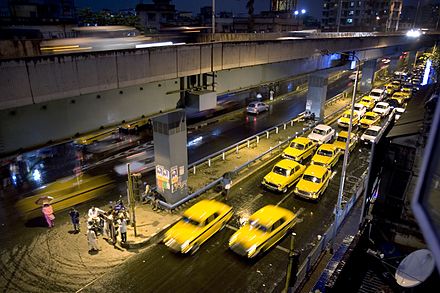
.jpg/440px-AC_Taxi_in_Howrah_(18_June_2022).jpg) Kolkata just wouldn't look the same without the plethora of yellow Ambassador taxis that ply on its roads. They're easily available, relatively cheap, and will use their meters, at least in theory.
Kolkata just wouldn't look the same without the plethora of yellow Ambassador taxis that ply on its roads. They're easily available, relatively cheap, and will use their meters, at least in theory.
However, Kolkata taxis sometimes refuse to go to some distant remote locations (like Behala, Bansdroni, Howrah) where they wouldn't get any passengers while returning. If they agree, they will demand high pay; be ready for such a situation. New taxis have been introduced, which are called "No Refusal Taxis", but sadly, these taxis are also no different.
Some of the new taxis are air-conditioned; usually, these will also have a "Same Fare" sign on them. There is a 25% extra charge if you want the air-conditioner to be turned on in such taxis. In Kolkata, it is a crime for taxis to refuse a request to go to certain destinations, and they can be fined, but if you threaten the driver with a complaint to the police, they will simply ask you to complain.
Cars by app-based services such as Uber and Ola are easily available (round-the-clock), reasonably priced, comfortable and have been embraced by citizens.
By metro
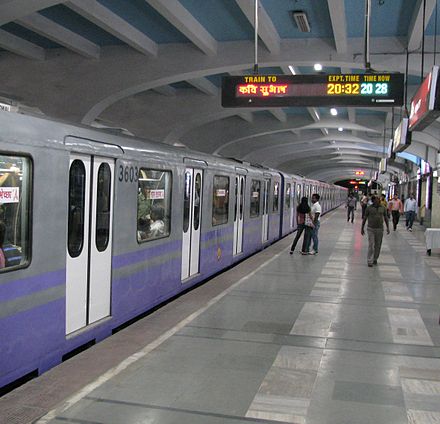
The oldest rail rapid transit system in India, the Kolkata Metro is the fastest, cleanest, most reliable, least crowded (though still rather crowded) and most efficient of all the transportation Kolkata has to offer. As of 2023, three lines are operational and the other two are in construction.
The four-seat sections at each end of a coach are reserved for senior citizens and the physically challenged. The two middle seat sections, between the general seat sections on each side, are reserved for women. Smoking is also strictly prohibited on the metro premises. Violating any of these incurs a penalty.
By tram
 Kolkata has the only tram service in all of India and the oldest surviving electric tram network in Asia. Though decommissioned in some parts of the city, electric trams are still one of the means of travelling between a few places within the city. Operated by WBTC since 2016, they move slowly on the laid tracks in traffic-jammed streets, but they are environment-friendly (no emissions on the street, only at the source of energy generation). The network includes 25 tram routes.
Kolkata has the only tram service in all of India and the oldest surviving electric tram network in Asia. Though decommissioned in some parts of the city, electric trams are still one of the means of travelling between a few places within the city. Operated by WBTC since 2016, they move slowly on the laid tracks in traffic-jammed streets, but they are environment-friendly (no emissions on the street, only at the source of energy generation). The network includes 25 tram routes.
By train
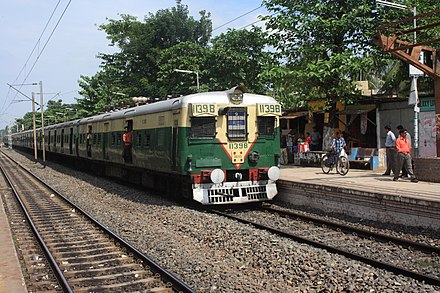
By bus
.jpg/440px-Calcutta_city_bus_(7354429936).jpg) The city has an extensive bus network (possibly the most exhaustive in the whole of India) and this is the cheapest, though not always the most comfortable means of transport. The routes are written all over the colourful buses in Bengali and also in English. The conductors call out their destinations to everyone he's passing and all you have to do is wave at the bus anywhere and it will stop, at times causing a small queue of other cars behind it.
The city has an extensive bus network (possibly the most exhaustive in the whole of India) and this is the cheapest, though not always the most comfortable means of transport. The routes are written all over the colourful buses in Bengali and also in English. The conductors call out their destinations to everyone he's passing and all you have to do is wave at the bus anywhere and it will stop, at times causing a small queue of other cars behind it.
Esplanade is a major bus terminus in Kolkata. Karunamoyee in Bidhannagar is another major bus depot. Some buses operate from the Babughat area in Maidan as well.
Among the buses that ply the city streets, the deluxe buses run by JNNURM (Jawaharlal Nehru National Urban Renewal Mission) and WBTC (West Bengal Transport Corporation) are probably the better option. Air-conditioned buses (Volvo) are also available to many destinations.
By rickshaw
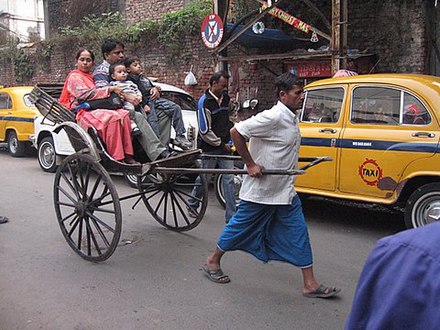
.jpg/440px-Auto-rickshaw_in_Kolkata_(18_June_2022).jpg) There are four types of rickshaws in Kolkata: human-pulled rickshaws, cycle rickshaws, auto-rickshaws and electric rickshaws.
There are four types of rickshaws in Kolkata: human-pulled rickshaws, cycle rickshaws, auto-rickshaws and electric rickshaws.
Rickshaws pulled by men are a common sight in Kolkata and they are mainly found in some old localities of Kolkata. These rickshaws usually operate over short distances and mainly run on narrow lanes and they are not allowed to ply over main roads. They take more fare than cycle-rickshaws.
Cycle rickshaws are the most convenient mean of transport in Kolkata. They are very cheap and can accommodate two adults. Unlike auto-rickshaws, they can go to any place in a particular region.
In Kolkata, there are shared auto-rickshaws, i.e. the auto-rickshaws don't ferry just a single person but four people at a time. Auto-rickshaws have a fixed route and a vehicle of that route travel on that particular route only. However, unlike taxis, they don't refuse passengers. The fare of an auto-rickshaw is much less than that of a taxi, with the minimum fare being ₹10. Be prepared to give the exact fare as they are very reluctant to give change.
Electric rickshaws, popularly known as totos or e-rickshaws, are battery-operated alternatives to auto-rickshaws and cycle rickshaws because of their low fuel cost and less human effort compared to cycle rickshaws. They generally operate in suburban Kolkata.
The fare of rickshaws is not set by meters, as fares are fixed by the respective rickshaw association. After 10 PM, rickshaw drivers may demand an exorbitant fee and the same goes for times during natural calamities such as heavy rainfall.
By ferry
The river offers a less crowded but slow traffic medium. There are several points (popularly called ghats and jetties) on the bank of the river from where you can board several regular routes of ferry services. Ferries can be fairly large launches to small improvised motorized boats. Even if you don't get any exotic manual boat as you get in Varanasi, the river transport of the city lets you go to several old spots near the bank in a hassle-free manner with an additional dash of the view of decadent river front of the city.
By rental car
Privately owned rental car places are available throughout the city. Rates depend on the make, model, size and comfort level of the car. Agreements are flexible, for example, cars can be rented even for a couple of hours at an hourly rate. Most rental cars are accompanied by a driver from the rental agency.
By foot
Except in Maidan and newly developed areas, much of Kolkata is not so pedestrian-friendly. In the more tourist-oriented areas, you'll be constantly accosted by beggars and touts. Crossing roads often involves wading across multiple lanes of heavy traffic. Try your best to move in a predictable straight line, so vehicles can weave around you. Better yet, latch onto a group of locals and cross in their shadow. If you really want to walk around, these places would be good:
- Walk along the Hooghly River. There is a good promenade near Eden Gardens.
- Walk along Chowringhee Road (officially Jawaharlal Nehru Road), which sets the pace as you unravel the rare beauty of this city. Across the road sweeps a huge, lush green, open parkland called the Maidan, centring around Fort William, the massive and impregnable British citadel built in 1773. A rambling green 'lung of Kolkata', the Maidan is a hub of diverse activities.
Talk
Being in West Bengal, the native language of the people of Kolkata is Bengali. However, most educated locals also speak English and some Hindi. Many shopkeepers and taxi drivers are able to communicate in broken English, and government offices will typically have English-speaking staff on duty. Although it is generally not a problem getting by with English, learning some Bengali will make your trip much smoother.
See
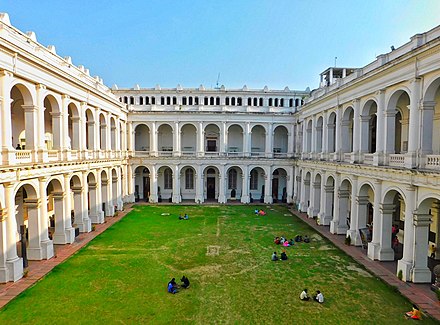

Do
Take a tram ride in Kolkata. The city has the only active tram service in India and has become an icon of Kolkata. They move slow on the laid tracks in traffic-jammed streets.
Several modern cinemas are dotted around the city, including INOX with several locations, Fame at Metropolis Mall in Highland Park, and RDB Adlabs at RDB Boulevard, Near Infinity Building in Sector-V, Bidhannagar, all showing Indian and American blockbusters. Kolkata also has many established theatre houses, which host events by international theatre groups frequently. Such events draw people from around the globe as it offers a unique opportunity to share culture and ideas.
Unlike most of cricket-obsessed India, football (soccer) reigns supreme in Kolkata, with the local clubs Mohun Bagan Athletic Club and East Bengal Club being the most successful in India. They contest the Kolkata Derby biannually, which is considered by many to be the oldest and most intense football rivalry in all of Asia.
Events
_%E0%A6%AC%E0%A7%8D%E0%A6%B2%E0%A6%95_%E0%A6%AC%E0%A6%BF%E0%A6%A7%E0%A6%BE%E0%A6%A8_%E0%A6%A8%E0%A6%97%E0%A6%B0_%E0%A6%A6%E0%A7%82%E0%A6%B0%E0%A7%8D%E0%A6%97%E0%A6%BE_%E0%A6%AA%E0%A7%81%E0%A6%9C%E0%A7%8B_%E0%A7%A8%E0%A7%A6%E0%A7%A7%E0%A7%AE.jpg/440px-%E0%A6%AC%E0%A6%BF._%E0%A6%87._(%E0%A6%AA%E0%A6%B6%E0%A7%8D%E0%A6%9A%E0%A6%BF%E0%A6%AE)_%E0%A6%AC%E0%A7%8D%E0%A6%B2%E0%A6%95_%E0%A6%AC%E0%A6%BF%E0%A6%A7%E0%A6%BE%E0%A6%A8_%E0%A6%A8%E0%A6%97%E0%A6%B0_%E0%A6%A6%E0%A7%82%E0%A6%B0%E0%A7%8D%E0%A6%97%E0%A6%BE_%E0%A6%AA%E0%A7%81%E0%A6%9C%E0%A7%8B_%E0%A7%A8%E0%A7%A6%E0%A7%A7%E0%A7%AE.jpg) Durga Puja, a festival honouring the Hindu goddess Durga, takes place between September and October, depending on the traditional phases of the Moon. The biggest festival for Hindus in Bengal, Kolkata takes on an almost carnival-like ambience. Streets shut down for the construction of pandals (প্যান্ডেল, pênḍel), large stands that depict events from the Ramayana and crowds flock to the biggest and best ones. Durga Puja in Kolkata has been listed as a UNESCO Intangible Cultural Heritage in 2021. A good time to visit, unless you have a fear of crowds.
Durga Puja, a festival honouring the Hindu goddess Durga, takes place between September and October, depending on the traditional phases of the Moon. The biggest festival for Hindus in Bengal, Kolkata takes on an almost carnival-like ambience. Streets shut down for the construction of pandals (প্যান্ডেল, pênḍel), large stands that depict events from the Ramayana and crowds flock to the biggest and best ones. Durga Puja in Kolkata has been listed as a UNESCO Intangible Cultural Heritage in 2021. A good time to visit, unless you have a fear of crowds.
The Indian Premier League (IPL) is the main club cricket league in India. It is one of the world's most widely attended sporting events, and if you are in Kolkata during the season (April–May), consider watching the home team (Kolkata Knight Riders) play at Eden Gardens.
The Kolkata Book Fair takes place from the last week of January to the first week of February. It is the largest book fair in Asia and is a significant event in the city. Milan Mela at East Kolkata was used to be the venue of the Kolkata Book Fair till 2022, when the fair took place at Central Park. The similarly-named but smaller Kolkata District Book Fair takes place at Netaji Indoor Stadium in May.
The Kolkata International Film Festival (KIFF) takes place from 15 December to 22 December every year at 4PM. Although the opening and closing ceremonies takes place at the Netaji Indoor Stadium, Nandan is the main centre for the festival.
Learn
Kolkata is a key centre of learning in India. The most famous universities and colleges in Kolkata are the Medical College and Hospital, Jadavpur University, the University of Calcutta, the Presidency University and Indian Institute of Management Calcutta. Apart from undergraduate, postgraduate and doctoral courses, there are several training and diploma-level institutes and polytechnics that cater to the growing demand for skill-based and vocational education.
Work
Volunteering is a real option here with several opportunities.
- Brother Xavier's New Hope. Home for orphans of Kolkata's red light district. A much smaller mission than Mother Teresa's which one man built from the ground up. Brother Xavier and the children always need volunteers and funds.
- Mother Teresa's Mission accepts volunteers to help in its multiple projects around the city. Enquire at the motherhouse.
Buy
Traditionally Kolkata had certain shopping areas or districts. The New Market area was considered the core of fashionable marketing. That was the marketplace for the British and later patronised by the more sophisticated Indians. There were large markets in Burrabazar, Hatibagan-Shyambazar, Gariahat and Bhowanipore. There were several specialised markets: electrical goods at Chandni Chowk, jewellery at Bowbazar, books at College Street, fish at Maniktala, flowers at Jagannath Ghat, the Maidan market for sports goods and so on.
The malls are a more recent addition. The South City Mall, one of the biggest in the city, is in its southern fringes. The Quest Mall is another large shopping mall at Park Circus, an old neighbourhood in South Kolkata. There are large number of malls in East Kolkata and new malls are being added.
Eat
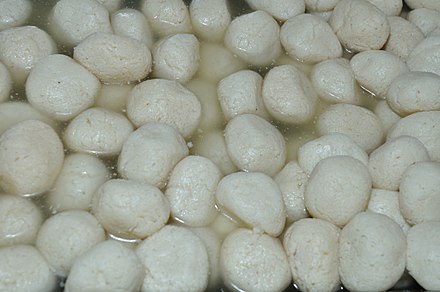
The joy of food in Kolkata is in its Indian foods. Nizam's (23/24, Hogg St), close to New Market, is credited with the invention of the famous Kati Kebab roll and still serves up the best of the best. For Mughlai dishes, there are several places to eat in the Park Circus area and there are others all over the city.
In terms of sweet, Kolkata is best known for its rôsogolla, consisting of balls of chhena (a moist, softer cheese than paneer) cooked and permeated in a light rose-scented syrup. Although the origin of rôsogolla is disputed between Odisha and Bengal, the first canned rôsogollas were sold in this city in 1930, after which they took off in popularity across South Asia. A variant of the dish is rôsomalai where the chhena balls are immersed in sweet thickened milk instead of syrup, providing a creamier feel to the sweet.
Besides Bengali foods, Kolkata is also the home of Indian Chinese food. Chinese restaurants are everywhere so try the Indian variant of hot and sour soup and the famous Indian Chinese dish of chilli chicken. The best place to have Chinese is to visit Chinatown near Tangra, East Kolkata. It serves the best of the Chinese dishes and you will find plenty of large, small & medium restaurants. There are some restaurants serving Thai, Mediterranean or Italian food.
Kolkata also has many excellent vegetarian restaurants ranging from budget to expensive ones. There are two types: those serving North Indian and those serving South Indian food. For those looking for vegetarian street foods, one can find ubiquitous jhal muri (somewhat similar to bhel puri of Mumbai) a concoction of puffed rice mixed with various spices, vegetables & other ingredients available at street vendors all over Kolkata.
Street vendors selling egg rolls/chicken rolls abound and their freshly prepared kati rolls are safe to eat. Mughlai Paratha (earlier it was a paratha stuffed with minced meat, but now the minced meat has been replaced by cheaper but tasty alternatives) is a Kolkata speciality. Fuchka, the Kolkata version of paani-puri, but very different from the ones found in Delhi, is available on the streets but be wary of the tamarind water. It never troubles the local people and outsiders can safely taste this delicacy as long as they don't take too much.
Earlier, the restaurants were standalone entities. A cluster of restaurants in a single mall is a comparatively new idea and has become popular.
Drink
There are plenty of places to buy alcohol around the city. Kolkata has many pubs and bars, which are frequented by youngsters as well as its older residents. Some pubs have live concerts or DJs. They include:
- Someplace Else (The Park)
- Roxy (The Park)
- Aqua (The Park)
- The Myx (Park Street)
- Olypub (Park Street), famous for the beer and the beef steak
- Mocha (AJC Bose Road)
- Underground (HHI, AJC Bose Road)
- Nocturne (Theatre Road)
- Shisha Bar Stock Exchange, The Factory Outlet (22 Camac Street)
- Chili's (Quest Mall, South City Mall, Acropolis Mall Kasba)
- Cafe Mezzuna (Forum Mall Elgin Road, South City Mall)
- Hoppipola (Acropolis Mall)
- Afraa Lounge (City Centre Salt Lake)
- Fairlawns (Sudder Street)
- Big Ben (The Kenilworth, Little Russel Street)
All pubs are supposed to shut shop by midnight or 1AM. So go early if you want to enjoy yourself in the club.
Sleep
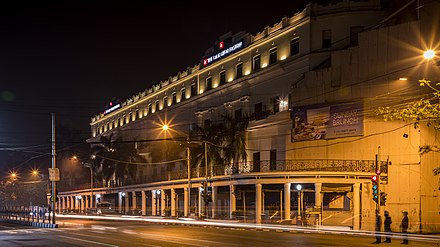 Kolkata has long had a concentration of budget backpacker hotels in the Sudder Street area and many of these are colonial era gems, albeit decaying ones. Sudder Street is centrally located and is well connected by public transport. Both the major railway stations at Howrah and Sealdah have many hotels around them. Most of them might be only licensed to accommodate Indian citizens. Be sure to not walk with a local "friend" or guide, unless you want to have higher prices. There are some hotels in South Kolkata. The growth of the IT Sector and hospital facilities in East Kolkata has led to development of hotels in that district.
Kolkata has long had a concentration of budget backpacker hotels in the Sudder Street area and many of these are colonial era gems, albeit decaying ones. Sudder Street is centrally located and is well connected by public transport. Both the major railway stations at Howrah and Sealdah have many hotels around them. Most of them might be only licensed to accommodate Indian citizens. Be sure to not walk with a local "friend" or guide, unless you want to have higher prices. There are some hotels in South Kolkata. The growth of the IT Sector and hospital facilities in East Kolkata has led to development of hotels in that district.
However, if money is of no object, you can stay at Great Eastern, ITC Sonar, Taj Bengal and JW Marriott Kolkata. British-era clubs such as Tollygunge Club, Calcutta Club (AJC Bose Rd), Saturday Club (Theatre Rd) and Bengal Club (Russel St) have lavish rooms for rent. However, they only accept bookings through members.
Stay safe
 Kolkata is one of the safest metropolitan areas in India, and the people are friendly and helpful, unlike in most of India's other large cities. Violent crime in Kolkata is more or less like any other large Indian city. There has been some incidents of chain, bag and mobile snatching in railway stations and empty roads. Be on guard for anybody trying to help you by giving you unsolicited directions or travel advice. Do not blindly rely on the advice of taxi and auto drivers. Carry your cash and cards in a secure money belt, with only enough cash for a few hours at a time in your wallet or other accessible place. Beware during the rush hours in bus terminals and railway stations as many pickpockets will try to get your belongings.
Kolkata is one of the safest metropolitan areas in India, and the people are friendly and helpful, unlike in most of India's other large cities. Violent crime in Kolkata is more or less like any other large Indian city. There has been some incidents of chain, bag and mobile snatching in railway stations and empty roads. Be on guard for anybody trying to help you by giving you unsolicited directions or travel advice. Do not blindly rely on the advice of taxi and auto drivers. Carry your cash and cards in a secure money belt, with only enough cash for a few hours at a time in your wallet or other accessible place. Beware during the rush hours in bus terminals and railway stations as many pickpockets will try to get your belongings.
Visitors outside the city are often magnets for beggars, frauds and touts. In South Kolkata, beggars often knock at the glass windows of cars. It does little good to get angry or to say "No" loudly. The best response is to look unconcerned and ignore the behaviour. The more attention you pay to a beggar or a tout, positive or negative, the longer they will follow you hoping for a donation.
Police
The Kolkata Police is a white-uniform police force serving the city. While most police officers are honest and helpful, you may find a lot of officers who may be corrupt and unhelpful. For emergencies, you can dial 100 for police assistance. For non-emergencies, or to report a crime, visit the nearest police station. See the district articles for police stations.
Emergency numbers
- Airport, +91 33 2569 1002.
- Fire, 101.
- Medical, 102.
- Police, 100.
Stay healthy
Air pollution is a major problem in Kolkata, with regular smog and haze. As of 2022, Kolkata is ranked as India's second most polluted city after Delhi, with pollution levels often in the "very unhealthy" or "hazardous" range. Anyone visiting the area should try to limit outdoor and exhausting activity. Have masks (single-use surgical masks are okay), tissues, and eyedrops ready when going out.
Connect
Landlines
The area code for Kolkata is "33" (prefix "+91", if you are calling from outside India). Phone numbers are eight digits long.
Phone booths
Public call booths can be found easily throughout the city from where local, national, and international calls can be made. Else local SIM card can be used for connectivity.
Mobile phones
Mobile phone coverage is excellent with all major mobile service providers offering their services in the city. It might be a good idea to buy a cell phone and use one of those prepaid plans to get yourself connected while you are in the city.
All mobile numbers are 10 digits long and begin with a "9", "8", "7" or "6". Do not dial the city prefix for mobile numbers. If you don't get through to a mobile number, try adding a "0" before you dial it.
Cybercafes
Internet cafes are available in plenty and charges ₹10-25/hour. You need to show your identity card to use internet in those cafes. As a precaution, change your password after you use it at a cybercafe or do private/incognito browsing.
Cope
Consulates
- 🇧🇩 Bangladesh, Circus Ave (just E of AJC Bose Rd), 22.5414929°, 88.3589803°, +91 33 2290 5208, +91 33 2290 5209, +91 33 2288 6536 (after hours). Issues 15-day visas. Applications are received at window #4 M-F from 9-11AM, and visas are generally ready the next afternoon. Bring 3 passport photos. As of December 2018, there seems to be a new policy: the application should be first filled online as directed on their website. You can use the payed services of the stands in front of the High Commission to fill the forms for you, just bring one or two passport photos. Beware that at least in some cases, the Kolkata office can be reluctant to issue visa for non-Indians, and the process requires assertiveness and patience. 2020-03-02
- 🇨🇳 China, EC-72, Sector I, Salt Lake, 22.583483°, 88.407001°, +91 33 4004 8169, chinaconsul_kkt@mfa.gov.cn. M-F 10AM-12:30PM. 2020-03-02
- 🇫🇷 France, 26 Park Mansions, Park St, 22.5184239°, 88.3286423°. 2020-03-02
- 🇩🇪 Germany, 1 Hastings Park Rd, Alipore, 22.5249993°, 88.3321313°, +91 33 2479 1141, +91 33 2479 1142, +91 33 2479 2150, +91 33 2439 8906. The origins of the German consulate in Kolkata can be traced to before the existence of Germany itself, to the establishment of the consulate of the Kingdom of Hanover in 1851 and the Consulate of Prussia in 1854. 2020-03-02
- 🇮🇹 Italy, 3, Raj Santosh Rd, Alipore, 22.524072°, 88.325556°, +91 33 24792414, +91 33 24792426, +91 98312 12216, consolatogenerale.calcutta@esteri.it. M-F 10AM-noon. 2020-03-02
- 🇯🇵 Japan, 55, M. N. Sen Lane, Tollygunge, 22.4874321°, 88.3409411°, +91 33 2421-1970. 2020-03-02
- 🇳🇱 Netherlands, 5, Rameshwar Shaw Road, 22.54837°, 88.37208°, +91 33 2289 7020, +91 33 2289 7676, consulkolkata.netherlands@gmail.com. 2022-07-24
- 🇬🇧 United Kingdom, 1A Ho Chi Minh Sarani, 22.5472312°, 88.347796°, +91 33 2288 5173, +91 33 2288 6536 (after hours). 2020-03-02
- 🇺🇸 United States, 5/1, Ho Chi Minh Sarani, 22.547231°, 88.347796°, +91 33 3984 2400, consularkolkata@state.gov. It is the oldest diplomatic post of the U.S. in India, and the second oldest in the world (the oldest being in London). Benjamin Joy was appointed the first American Consul to Calcutta by George Washington in 1792, upon the express recommendation of then-Secretary of State, Thomas Jefferson. 2020-03-02
Hospitals
Kolkata has a number of medical colleges and hospitals, with the oldest being the Calcutta Medical College (now Medical College and Hospital, Kolkata) in North Kolkata. See the district articles for medical colleges and hospitals.
Newspapers
Local newspapers can be handy and reliable sources for day to day updates about the city. The city has number of newspapers and other publication that list local happenings. There are different options for newspapers including daily, weekly and bi-weekly. Some of the popular newspapers are Bartaman (Bengali), Anandabazar Patrika (Bengali), The Statesman, The Times of India, Indian Express, Hindustan Times and Free Press Journal. For the business updates, check Economic Times.
Go next
West Bengal
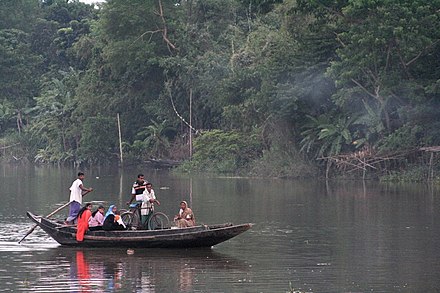
- Bishnupur — Famous for terracotta temples, clay sculptures and silk sarees.
- Darjeeling Hills — A mountainous region home to Darjeeling, Kalimpong and Mirik. When Darjeeling is your destination, you could travel the last 72 km by a combination of bus/train and the famous Darjeeling Himalayan Railway.
- Digha — A beach town in the southern part of the state. Buses from Esplanade Bus Station.
- Santiniketan — Famous for the ashramik school and university founded by Bengali poet Rabindranath Tagore, the town is also known for its handmade leather crafts and kantha stitch sarees.
- Sundarbans National Park — Part of the largest littoral mangrove in the world, and home to the famous Bengal Tigers.
Elsewhere
- Bangladesh — Tickets for buses running to the border and Dhaka can be reserved at Shyamoli Yatri Paribahan. Beware that several travel agencies around this area also sell tickets for these buses, but at very inflated prices. At the border, it's best to change money on the Indian side.
- Bhutan — Tucked away in the corner of the bus station is a small Bhutanese Government kiosk selling tickets for buses running to the Bhutanese border town of Phuentsholing. Buses depart Tu Th Sa at 9PM, and the 18-hr journey costs ₹300.
-Titodutta-%E0%A6%95%E0%A6%B2%E0%A6%95%E0%A6%BE%E0%A6%A4%E0%A6%BE.wav/440px-LL-Q9610_(ben)-Titodutta-%E0%A6%95%E0%A6%B2%E0%A6%95%E0%A6%BE%E0%A6%A4%E0%A6%BE.wav)
.JPG/440px-SC_Mall_(1).JPG)